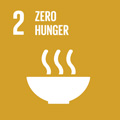- Docente: Francesca Patrignani
- Credits: 6
- SSD: AGR/16
- Language: Italian
- Teaching Mode: In-person learning (entirely or partially)
- Campus: Cesena
- Corso: First cycle degree programme (L) in Food Technology (cod. 8528)
-
from Sep 15, 2025 to Dec 09, 2025
Learning outcomes
At the end of the course, students will understand the structural, physiological, and metabolic characteristics of various microbial species and will be able to manage and optimize their activity in raw materials of food interest.
Course contents
The Biology of Microorganisms Course will be developed through the treatment of various topics (listed below) that will lead to knowledge of the structural, physiological and metabolic characteristics of the various microbial species.
Introduction. What is microbiology and general descriptions. Difinition of microrganisms and importance of the microbiological heritage in relation to Food Science.
Bacterial classification. Phylogenesis. Methods for classification; genotype and phenotype. Definition of the most important genera and species of interest for the Food sector. Taxonomy of Bacteria: most important Phyla (Proteobacteria, Firmicutes, Actinobacteria). Characteristics of the main microbial groups
Taxonomy of fungi: yeasts and moulds important for Food Science
Structure of cells. Composition and functions of the microbial cells. Eukaryotic and prokaryotic cells: differences and common traits. Morphology and structure of microbial cells. Spore formation.
Microbial growth. Culture media: definition, classification, preparation. Microbial counting. Microbial growth curve: lag, exponential, stationary ans death phase. Diauxic growth. Chemostats. Homeostasis. Main factors able to influence growth curve: temperature, pH, aw and oxygen.
Nutrition and transport systems. Chemical component of cells. Energy (phototrophy, chemiotrophy, lithotrophy). Organic substance (autotrophy and organotrophy). Growth factors. Transport systems (primary, secundary group translocation).
Microbial metabolism. Energetic strategies. Fermentation and respiration. Electronic chain, redox potential and bioenergetics. Membrane carrier (NADH, quinones, cytochrome, Fe S proteins, flavoproteins). Proton Motive Force (PFM). ATP and CoA. Steps of the generation of PFM. ATPase
Energetic pathways. Glicolysis, Entner Doudoroff pathway. Oxidation of pentose phosphate. Fermentations: homolactic, heterolactic, alcoholic, mixed acid. Review of butandiolic, acetic, butyric, propionic, bifidobacteria pathway, Stickland reaction. Aerobic and anaerobic respiration. Krebs cycle. Anapleorotic and glyossilic pathway. Catabolism of macromolecules.
Assimilative metabolism and biosynthesis. Key intermediate products. Gluconeogenesis. Nitrogen assimilation. Sulphur assimilation. Phosphate assimilation. Aminoacid biosynthesis, Nucleotide biosynthesis.
Virus: introduction to Viral structure. Genetic material in viruses. Steps of viral replication. Bacterial viruses (fagi). Virulent fagi virulenti and temperate fagi. Characteristic of lysogenic fagi
Laboratory classes
Laboratory work will provide students an opportunity to apply theoretical and conceptual knowledge and will include:
- use of an optical microscope to observe different cell morphologies: bacteria, yeasts and moulds
- techniques for the purification and characterization of microbial isolates
- staining to differentiate and highlight components of the microbial cells: Gram and spore staining
- physiological and enzymatic test for the characterization of microbial isolates: catalase, oxidase, Voges-Proskauer test.
- tests to evaluate nutrients, oxygen and growth temperature requirements
- identification of isolates
- enumeration of cell cultures through direct and direct methods: optical density, Thoma cell counting chamber, direct plate counting
- evaluation of cell growth by plate counting techniques (inclusion and surface inoculum)
- analysis and discussion of experimental data: construction of growth curves and determination of growth parameters
Readings/Bibliography
Slides provided by the Professor.
Brock. Biologia dei microrganismi. Microbiologia generale, ambientale e industriale. Pearson editor
All the material (slide, papers) will be uploaded by the Professor into "Virtuale" platform.
Teaching methods
Theorical lessions and pratical laboratory course. If possible, seminars and lectures with experts in the field will be organized. Also guided tour in food industry, when possible, will be planned.
In order to attend the laboratory activities, the students must attend the couse 1, 2 and 3 on safety risks. All the information are reported at the following link:[https://www.unibo.it/it/servizi-e-opportunita/salute-e-assistenza/salute-e-sicurezza/sicurezza-e-salute-nei-luoghi-di-studio-e-tirocinio]
Assessment methods
The preparation of the students will be tested through a test with two types of questions. There are three open questions for each of which a maximum score of 3 points will be assigned. Then there are 25 multiple choice questions, for each of which a maximum of 1 points will be assigned. The time available to complete the test is 90 minutes. Text books, notes, and other tools are not admitted. The test is passed if a score of 18 points is reached. Score of 33 determines the obtaining of laude.
he exam dates will be managed in the spantime suggested by the Course and the students can book themselfes by using the website Alma Esami https://almaesami.unibo.it/almaesami/welcome.htm.
The final evaluation of the the course "Biology of Microorganisms and Food Inspection" is calculated as the arithmetic meas of the two units "Biology of Microorganisms" and "Food Inspection". Because it is an integrated course, the final score will be registered by Prof. Gerardo Manfreda
Teaching tools
Slides and seminars
Students with learning disorders and\or temporary or permanent disabilities: please, contact the office responsible (https://site.unibo.it/studenti-con-disabilita-e-dsa/en/for-students ) as soon as possible so that they can propose acceptable adjustments. The request for adaptation must be submitted in advance (15 days before the exam date) to the lecturer, who will assess the appropriateness of the adjustments, taking into account the teaching objectives.
Office hours
See the website of Francesca Patrignani
SDGs




This teaching activity contributes to the achievement of the Sustainable Development Goals of the UN 2030 Agenda.
